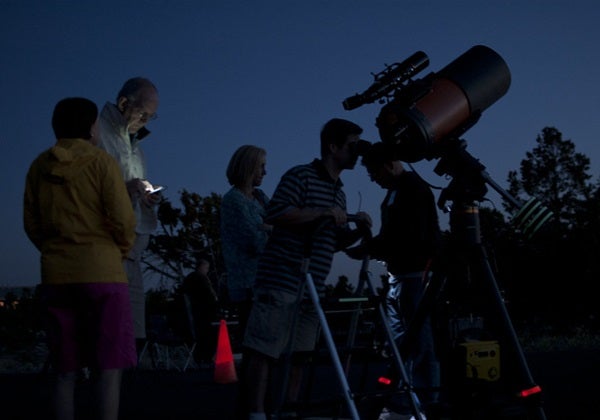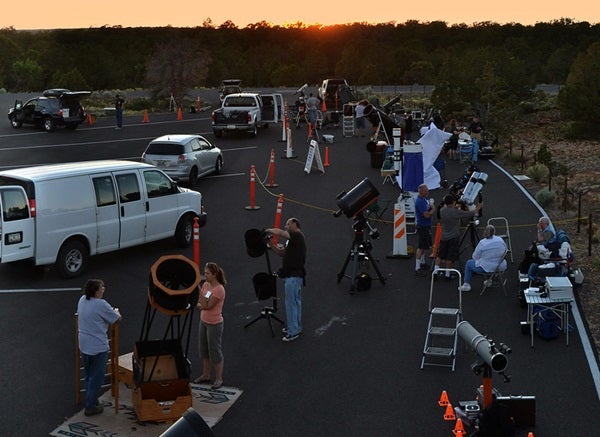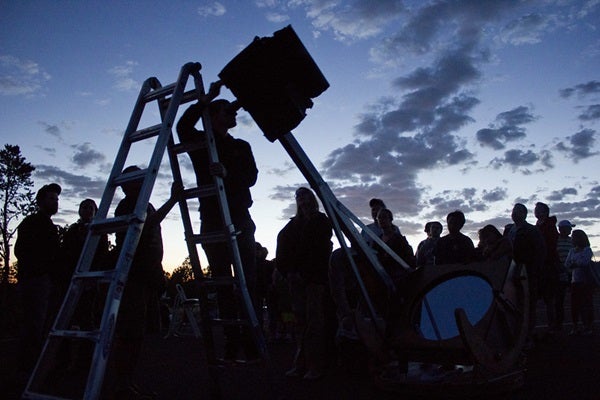Astronomy is a fascinating and rewarding hobby. It allows us to see beautiful sights, such as misty whirlpool galaxies and glittering star clusters, and witness incredible events, such as meteor showers and eclipses. It gives us a unique sense of perspective, too. But unless you live in a community with an astronomical society that organizes regular observing nights, chances are you’ll spend a lot of time alone, looking at the night sky with just your neighbor’s cat or an insomniac cow for company.
Of course, that’s part of the appeal for some people. They enjoy gazing at the night sky by themselves, enjoying precious time on their own far from the noise and hubbub of their busy everyday life. I know I relish my special nights stargazing alone inside the ruins of the 800-year-old castle that overlooks my town here in northern England. I can spend hours up there without seeing another soul.
But what if you’re an isolated astronomer who wants to enjoy the beauty of the night sky with others?
Social media allows you to contact and interact with other skywatchers, but tapping away on Twitter or Facebook is no substitute for meeting someone face to face. Fortunately, there are organized events you can go to if you want to meet real people. These events are usually held at remote sites with minimal light pollution, such as campgrounds within national parks, and they offer astronomers a chance to enjoy the wonders of the heavens with others, all under a sky much darker than the one at home.
These events are called star parties.
What is a star party?
I know from personal experience that making the decision to go to your first Star Party can be a bit daunting. After all, it’s a giant leap into the unknown, like preparing to go to a new a school or start a new job. When I was pondering signing up for my first star party, I couldn’t help worrying: “Will I fit in?” Even as we drove onto the campsite, I wondered if I would be welcomed as a newcomer or made to feel like a stranger walking into a busy saloon bar as the piano player falls silent.
I needn’t have worried, and you don’t need to either. Star parties are run by enthusiasts who were once newcomers just like you, and they are very friendly. There are regular attendees, of course, and amateur astronomy has its cliques just like every other hobby or pastime. But event organizers really do welcome new people and work very hard to make everyone feel included in their events, so you won’t feel like an intruder at all.
Tip: Remember that everyone you will meet at a star party, no matter how experienced they are or how big their telescope is, was a nervous newcomer once!
So, what does going to a star party actually entail?
Because many star parties are held at remote locations with dark skies they usually — but not always — involve camping. But there is camping, and there is camping. You might be happy to spend a “back to basics” weekend in a tent or you might prefer to roll up in a mobile home or a caravan, bringing all the comforts of home with you.
Tip: While some star party sites have electrical power supply, shower blocks, lecture rooms, and kitchen facilities, others are essentially just a field. Make sure you check carefully which facilities are going to be available before you book a place at a star party so you don’t have a nasty surprise when you get there.
Also — and I know this might come as a shock — you might need to be able to survive for several hours or days without your mobile phone or a connection to the internet, depending on the star party’s location. This can either be very liberating or a nightmare.
If all this sounds too intense, there are star parties where you don’t have to camp. You can just visit some events without staying overnight. But you must check this before you go and respect any rules about arrival and departure times.
What to expect
So, what’s a day like at a star party?
Obviously the main reason for going to a star party is to enjoy wonderful views of the night sky. However, they’re not exclusively nocturnal affairs. Mornings are generally spent socializing, discussing the previous night’s observing before an afternoon of events and activities. These can include talks by guest speakers or workshops to help attendees get the most from their equipment, learn how to take and process photographs, and maybe even sketch or paint the night sky.
Tip: It’s a good idea to bring some spending money with you. It’s not unusual for a star party to be attended by local traders with telescopes, cameras and other equipment for sale, sometimes at generously discounted prices.
As the afternoon progresses, people start to look at their watches more often, as if willing time to pass more quickly. Any who can get online anxiously check the local weather, too — and by the way, it’s a star party tradition to consult as many weather forecasts and apps as you can, then only believe the most optimistic one!
Finally, as the Sun goes down, an expectant hush will fall over the crowd. Guided by their red lights, people head back to their pitches to prepare for the long night ahead. As the darkness deepens, the air fills with the sounds of camera shutters clicking and telescope motors whirring, along with whispers and laughter, as everyone enjoys being out under a starry sky much darker than the one they see at home.
And then the wandering begins.
One of the greatest joys of a star party is looking through different telescopes. Here and there a telescope will be off limits because its owner is working on a special observing project or doing some serious astrophotography, but most people will be delighted to let you look through their equipment if you ask and will happily take requests if there’s something you particularly want to see.
This is probably my favorite thing about star parties — they give you an opportunity to look through instruments that you might never be able to afford. Even a small star party will have a good dozen or so very high-quality (i.e., very expensive) telescopes, all offering beautiful views of Messier objects, planets, and more.
So many reasons to go
So, now that you know what a star party is and how one works, you’re probably thinking, “Why should I go to one, and what would I get out of it?”
Firstly, you will have the chance to see the night sky in a whole new way. The skies above star parties are much darker than the one you are used to, so you’ll enjoy sights plucked straight from your dreams. If you’re into astrophotography, the lack of light pollution will allow you to take longer exposures and record more stars and much fainter objects than you have before.
You’ll also gain access to equipment you’d never otherwise get your hands on. This, too, will change your view of the universe. You might think your 6-inch or 8-inch gives great views, but trust me, when you make your way gingerly up a stepladder to peer into the coffee cup-sized eyepiece of a monster Dobsonian that looks like a cannon from a WWII battleship and come face to face with the curdled dust lanes of M42 or the star-frothed spiral arms of M31, something inside you will change.
Secondly, you’ll have a great time meeting and spending time with people who share your interest and passion. These are people who “get it” in a way your non-astronomer family and friends, through no fault of their own, just don’t.
Finally, what I’ve found through the years is that going to a star party is a great way to recharge your stargazing batteries. It’s easy to grow frustrated or disillusioned with our hobby. It’s heartbreaking when, after a week of clear skies, bad weather rolls in and makes us miss an eclipse we’ve looked forward to for years. Being unable to see a bright naked-eye comet because of light pollution is absolute torture. Such disappointments are part of the hobby, but let’s be honest — it’s awful, isn’t it? So if you have the chance to get away somewhere beautiful and stand under a truly dark sky, unspoiled by light pollution, why wouldn’t you?
If you go to a star party, you’ll remember why you fell in love with astronomy in the first place and appreciate again just how beautiful the night sky is.
What are you waiting for?












